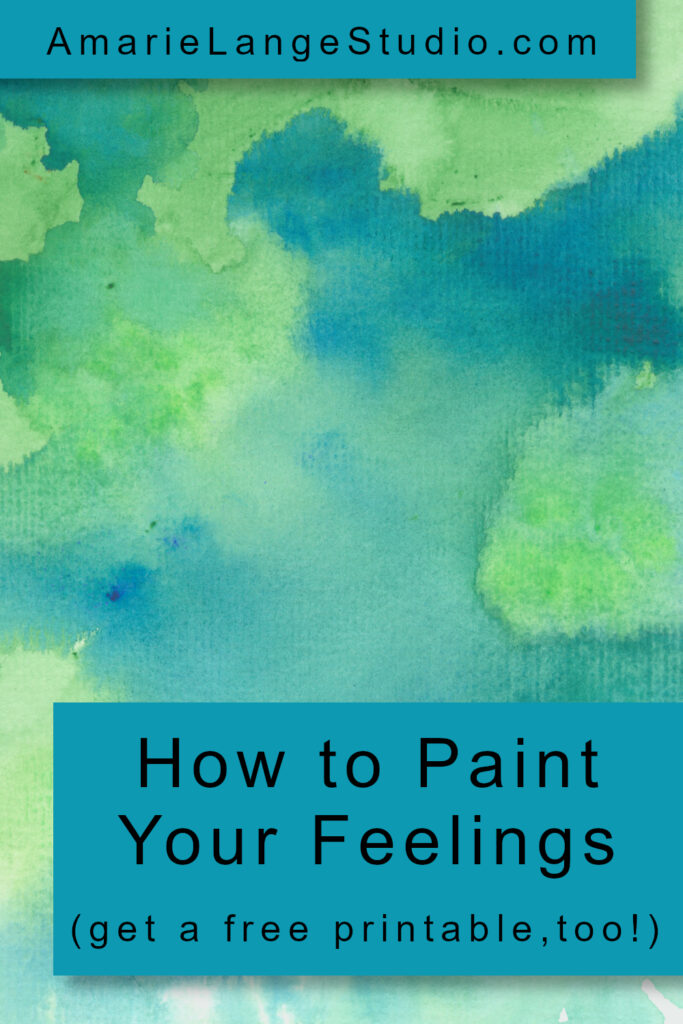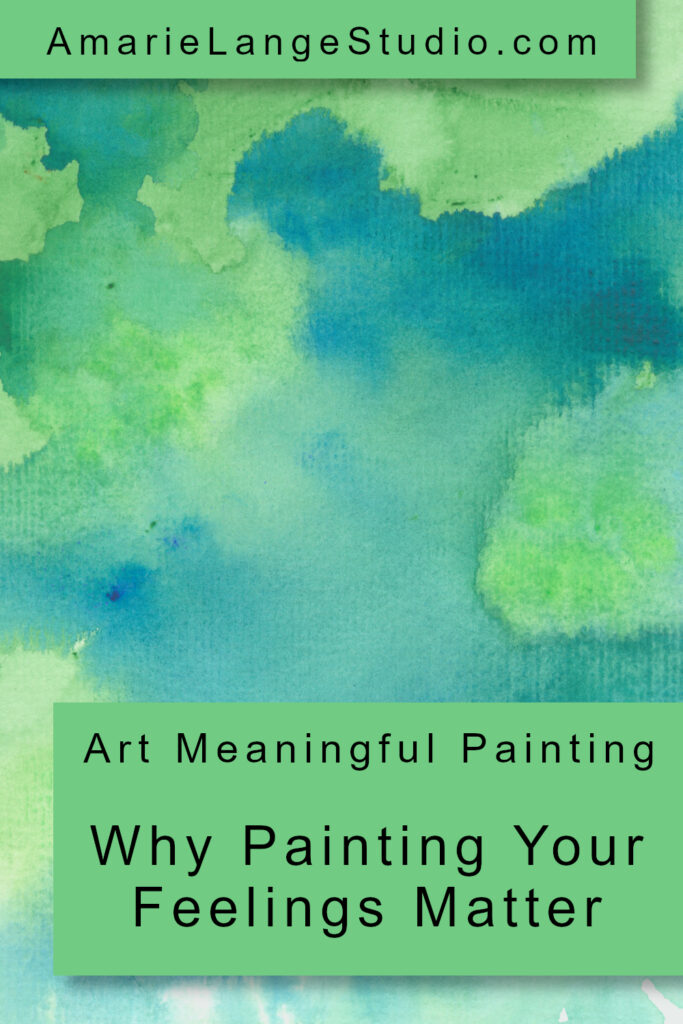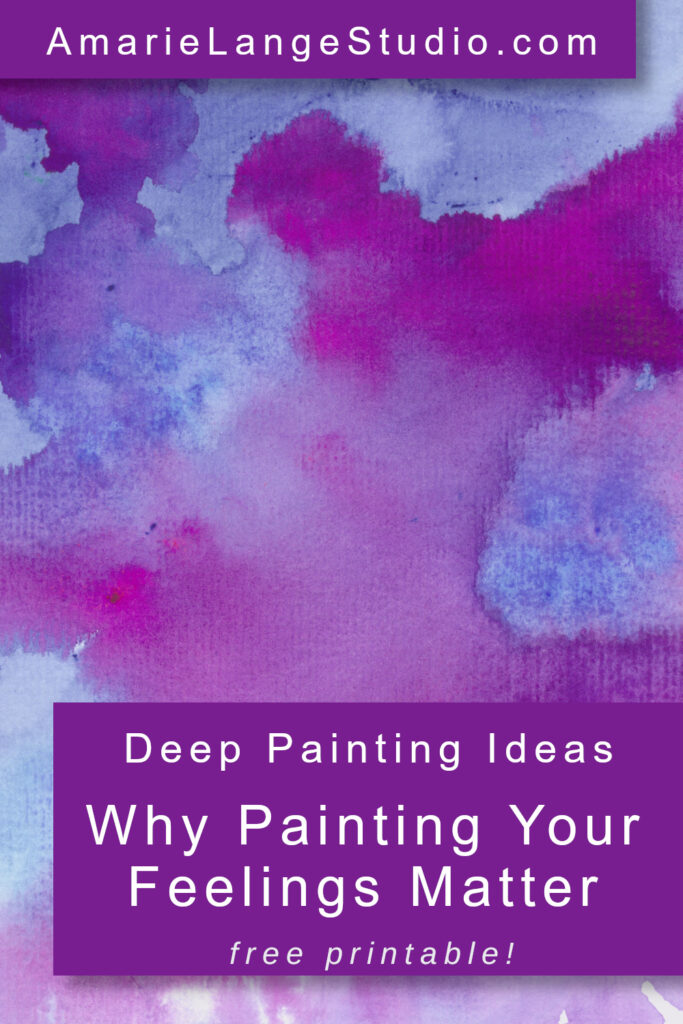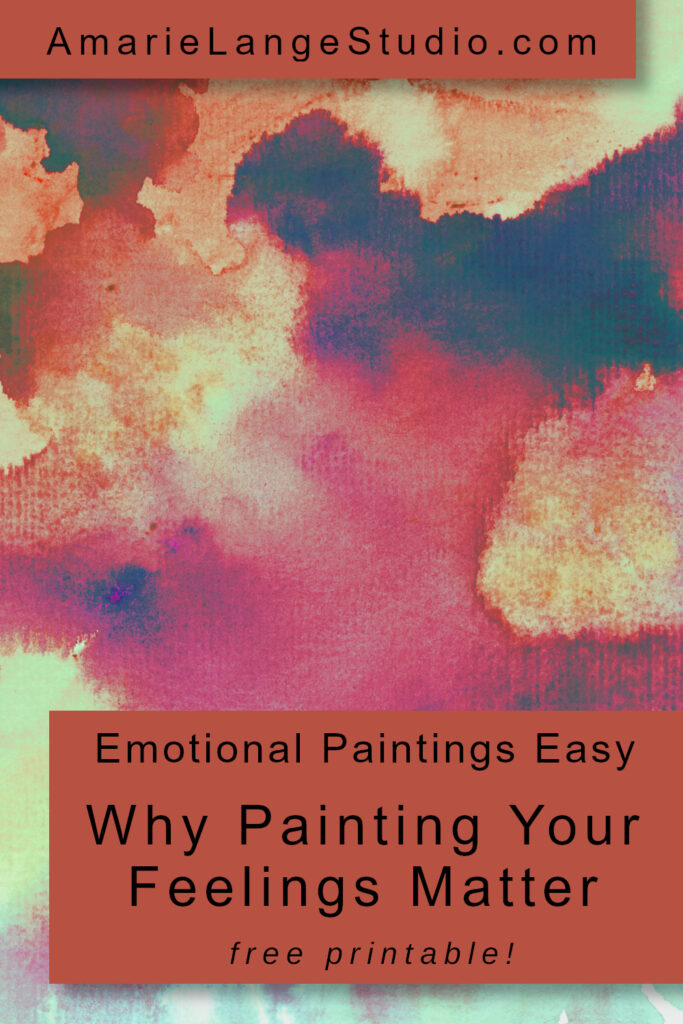
Ever felt something so strong that words just couldn’t capture it? Ever get stuck in an emotional state and want to get it out of your head and body to understand it better? Learning how to paint your feelings is a fantastic way to express emotions when language falls short. As an artist, I know that we can use color, texture, and movement to turn our inner world into a vibrant work of art that speaks louder than words.
I want to encourage you about this. I’m a certified Therapeutic Art Life Coach – not an art therapist. That means I can help people get in touch with their emotions, but that doesn’t include therapy. So ideas like how to paint your emotions are something I really connect to.
Whether you’re a total beginner or an experienced artist, painting your feelings is way less about technique and beautifully more about connection. I really believe in the power of connection. This creative idea is a therapeutic art form – and can be a transformative experience that helps you understand your own emotions, develop emotional intelligence, and find peace in the creative process.
Sound like something you might want to try? Let’s keep exploring.
Art – Meaningful Painting: Why Painting Your Feelings Matters
Art has always been one of humanity’s most powerful tools for self-expression. Honestly, from ancient cave drawings to modern abstract painting, people have used art to express emotions and explore their inner feelings. When I talk about something like art – meaningful painting, I’m referring to creating something that resonates deeply with your soul. The main connection we’re aiming for is a connection with yourself.
So, when you paint your feelings, you’re not just making something pretty—you’re working towards translating your inner world into color and form. This kind of artistic expression can:
- Help you process different emotions and experiences.
- Act as a form of art therapy or therapeutic art—even if you’re not working with an art therapist.
- Encourage mindfulness and self-reflection.
- Build confidence in your inner artist.
I like to think of this process as a tangible way to slow down and listen to my heart and body.
In addition, remember this: there’s no wrong way to create meaningful art. What matters is that it helps you connect with your inner world.
It may take some practice to enjoy these benefits, but I think the rewards can be worth the patience and effort.
Deep Painting Ideas: Going Beyond the Surface

If you’re ready to dive deeper then let’s explore a few deep painting ideas that go beyond using reference photos – which I find can cause creative blocks especially for beginning creatives. Our goal here is not just to paint what you see (although that can be helpful), but to focus on painting what you feel.
That’s why for this beginner post, I decided the easiest way to proceed is through abstract art.
To help you easily understand this therapeutic art process, I’ve kept this technique simple. But don’t be fooled; it’s still powerful for uncovering an emotional state.
My process for this technique

First, I painted the original abstract artwork. I wet my paper (working in sections for doing this) and applied dabs of color. Next, I would add a different dab of color and watch the colors blend. After this, I continued with colors I enjoy over the entire watercolor paper.
(Do use art paper that matches your art medium. For example, this is a watercolor tutorial, so it’s important to use watercolor paper or the results will be disappointing.)
Then I scanned the artwork and pulled it into my design software (I’m using free GIMP), where I changed the colors digitally so you can quickly see the difference a simple color change makes.
I also hand-traced the lines of my original painting to create a basic template you can download and trace onto your own watercolor paper. (See above.)
Eventually, doing this exercise without trying to “follow the lines” will help to open up your artistic exercise, but I don’t want that pressure to stop you from getting started, so I created the tracing to help you get past that if you want.
Here are some guidelines to help you explore your emotions through art:

- Start with a feeling. Think about what you’re feeling; is it a specific emotion—joy, grief, calm, or frustration? Then let it guide your painting process. I will add that music can sometimes tremendously enhance our ability to get in touch with our feelings, so try some background music and see if you enjoy it.
- Experiment with color schemes. Use warm colors (reds, oranges, yellows) to express energy or passion, and cool colors (blues, greens, purples) for calm or introspection. In this exercise, you might find you want to use both because you could be feeling multiple emotions at the same time, and therefore will resonate with moving from warm colors to cool or the other way round.
- Incorporate texture. Use different materials—sponges, palette knives, or even your hands—to add a sense of depth and movement. Even using different brushes can make a difference. Keep thinking about how you’re feeling as you use these unique painting tools.
- Play with shapes. Try geometric shapes or flowing lines to represent different emotions. You don’t need to use my line template if you don’t want to! Using shapes and watching them flow from your hands can be very powerful and may surprise you if you haven’t tried this before.
You can do this! The first step is simply picking up your art supplies and starting. Don’t worry about the finished work—focus on the art process itself.
To help you learn how to paint your feelings choose different colors

(Meditative Help: if it resonates to have positive messaging while adding color and design, you might want to try these printable Bible verses with artwork ready to color.)
You’ll remember, I digitized new colors into each example so that I could show you this process using the same abstract design again and again, but feel free to do a new abstract painting with different colors as you find yourself expressing different moods. The idea here is to get in touch (connection) with how you’re feeling and use color to express that, not to complete the task of using different colors on the same template and then checking off the task as completed without even slowing down. We want to think about what we’re feeling as we try different colors until a color resonates with the way we’re feeling.
I hope that makes sense.
Happy Paintings Feelings: Painting Joy and Positivity
Thankfully, not all emotional art has to be heavy or serious. Choosing to create happy paintings – feelings – really, is all about celebrating joy, gratitude, and lightheartedness. Painting happiness is a great way to reconnect with positivity and remind yourself of the beauty in everyday life.
I know from experience that painting in this manner can genuinely lift my mood. So this process is not just about how to paint your feelings that you’re feeling right now, but can also be instrumental in changing your emotional state.
Give it a try for yourself.
Here are a few ideas to try to practice how to channel joy in your art:
- Use bright and warm colors. Think sunshine yellows, coral pinks, and sky blues. These tones naturally lift your mood.
- Try playful brushstrokes. Loose, energetic movements can capture the feeling of laughter or excitement.
- Choose uplifting subject matter. When you’re ready, paint things that make you smile—flowers, sunlight, waves, or even abstract bursts of color like we’re using here.
You don’t need to be a great artist to paint happiness. The goal is to let your own emotions flow freely. This process has actually led me to cry tears of joy on occasion.
Emotion Painting Feelings: Letting Go and Letting the Flow Happen

Painting emotion – painting feelings – is all about surrendering control and letting your emotions guide your hand. This is where expressive painting truly shines.
Try this simple exercise with the same downloadable template found in this post or a fresh sheet of art paper:
- Pause and reflect. What’s bubbling inside you right now? Maybe primary emotions like fear, love, or anger—or a mix of subtle ones. Remember, they’re your emotions, and they’re valid. Feel them and let them go through your hands.
- Pick your palette, but don’t get too stressed about this part. Focus on choosing different colors that represent what you’re feeling. Trust your instincts. Don’t criticize yourself.
- Move intuitively. Let your brush, sponge, or even a black marker or ink pen move freely. Don’t overthink it—just feel and again, let it flow from your hands.
- Step back and observe. What do you see? What are you feeling now? Have your feelings changed? How does what you’ve created reflect your inner world?
This kind of painting can be incredibly freeing. It’s not about creating a masterpiece—it’s about connecting with your inner artist and discovering release through an art process you can use again and again to bless yourself with.
Emotional Paintings Easy: Simple Ways to Start Expressive Art
Remember, this is a beginner-friendly process (although if you’ve been painting awhile like me, it helps to go back to basics from time to time, remove the pressure to be an artist, and just create.) If you’re new to painting, don’t worry—creating these simple abstract emotional paintings can be easy and thoughtful, and is absolutely possible! You don’t need fancy supplies or advanced skills to create something powerful.
In addition to painting on the template I’ve provided for you, give these ideas a try.
- Color Mood Map: Paint blocks or swirls of color that match your mood.
- Music Response: We touched on music before. Try listening to a song that stirs your strong emotions and paint what you feel. Remember, don’t try to figure out where your art is going before you paint it; just paint! Trust your mind to work with your hands. With practice, this will get even better.
- Abstract Artist Exercise: Channel your inner abstract artist by focusing on movement and emotion rather than form. Try painting what I’ve shown you here without using the printable template. Just use a fresh sheet of watercolor paper. Think of it like dancing on your paper.
These exercises are a great way to explore your own emotions while building confidence with various techniques. You can do this! (I know I keep saying that, but I want you to believe it!)
Painting My Feelings: A Personal Journey
When I first started painting my feelings, it was hard to know where to begin. My starting point was simply the need to let go of something that kept swirling in my head. I knew it would help to release it in a healthy manner.
I gathered up a few art supplies, started with colors that matched my mood, and began painting without a plan. The finished work looked messy, but it felt honest and true to me. I realized that painting was helping me understand my inner feelings and process my different emotions.
It didn’t happen all at once, though.
There’s no magic here. This kind of expressive painting simply works when you work it, and it becomes a conversation between your heart and your hands. I love that, and I wonder if you might, too.
Deep Emotional Paintings: Turning Vulnerability into Art

Have you given this simple yet powerful way to paint your emotions a try? If you’re ready to go below the surface, try creating deep emotional paintings that explore themes of vulnerability, transformation, and healing. These artworks often come from moments of reflection or emotional intensity. Keep in mind that if painting this way causes you to feel worse or uncomfortable, you might want to stop and reflect on that by yourself or with a trusted guide.
Here are some additional ideas to consider:
- Layer your colors. Next, start with one emotion, then paint another on top. Let them blend and reveal complexity. Doing this with watercolors is wonderful yet definitely more advanced, so if you find yourself more frustrated than released trying this process, you might want to use oils or acrylics for artwork that requires layering.
- Add texture and depth. Use different materials like sand, string, or thick paint to create a tactile surface. Don’t be afraid to combine watercolors with acrylics, or colored pencils with inking. Using a high-quality sketch book can be a great place to try out different materials and techniques.
- Experiment with symbolism. Incorporate imagery that represents your inner world—doors, waves, eyes, or trees. Draw or paint your own or use magazine cutouts with your artwork to express what’s in your soul.
Are You Encouraged to Paint Your Feelings Yet?
(Useful Tip: know someone who could use encouragement while dealing with anxiety? Here are comforting words to share.)
Honestly, I hope you’ve found this post useful, at least as a starting point. Give yourself some grace, encourage yourself to try out techniques for how to paint your feelings, and learn how to release emotions or shift your mood.
I’m still encouraging you!
